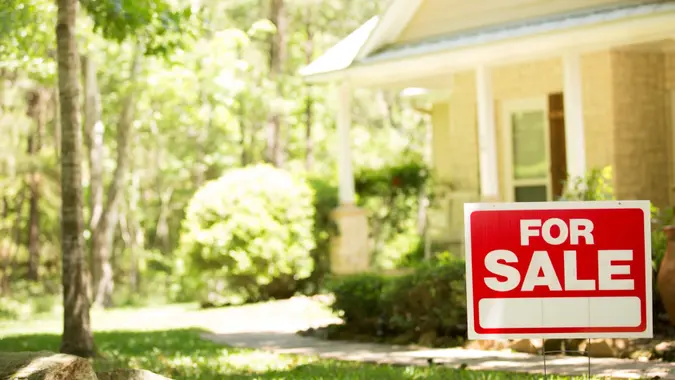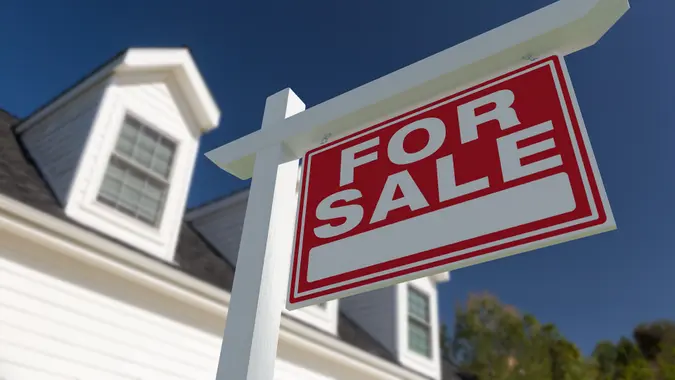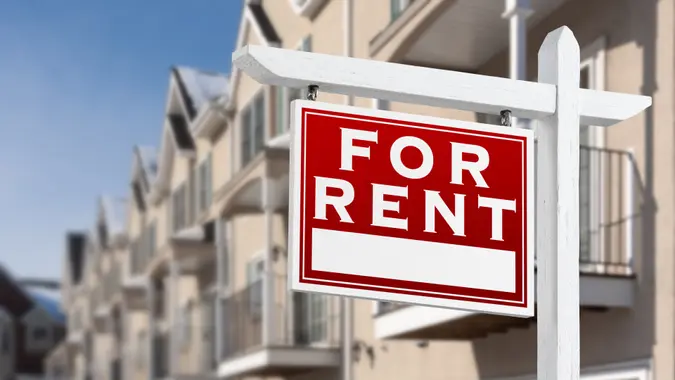Should You Buy a New Construction Home? Here Are the Pros and Cons

Commitment to Our Readers
GOBankingRates' editorial team is committed to bringing you unbiased reviews and information. We use data-driven methodologies to evaluate financial products and services - our reviews and ratings are not influenced by advertisers. You can read more about our editorial guidelines and our products and services review methodology.

20 Years
Helping You Live Richer

Reviewed
by Experts

Trusted by
Millions of Readers
High demand and high prices have made it tough for homebuyers to find a home they want at a price they can afford. One alternative is to build or buy a new construction instead of an existing one. While still comprising the minority of home sales, new constructions will continue to be a significant part of buyers’ searches, according to the National Association of Home Builders.
See: 3 Things You Must Do When Your Savings Reach $50,000
A brand-new home offers several perks that existing homes don’t. However, new construction can also present some challenges that you should consider before you buy.
Pros of Buying a New Construction Home
More homebuyers are choosing new construction for good reason. Here are some of the pros.
No Maintenance Worries
As charming as an older home can be, you always run the risk of facing expensive repairs in the not-so-distant future. A new roof, for example, averages $9,511, according to HomeAdvisor. A new hot water heater costs about $1,300, and a new HVAC system? About $7,500, on average.
You don’t have to worry about that during the early years of a new construction. In the event something goes wrong, you’ll likely have a warranty to cover it. HVAC, plumbing, and heating systems are usually warranted for two years, according to the Federal Trade Commission. Many builders cover major structural defects, such as a dangerous roof, for up to 10 years.
Get Exactly the Home You Want
A tight market for existing homes drives some buyers to make compromises they wouldn’t ordinarily make in terms of size, style, finishes, and other home features for the simple reason that they can’t find what they want. Building a new home gives you complete flexibility. You can build precisely the home you want within the confines of your budget and zoning considerations. Even if you’re buying a home already under construction, you might be able to select paint colors, flooring, tile, cabinetry, and other features to give the home a custom touch.
Modern Design
Builders design new constructions with modern floor plans, closets, and other storage, security, and home theater wiring — and electrical outlet placement. Older homes are often laid out in a way that makes rooms feel disjointed. What’s more, older wiring wasn’t designed for the number and types of appliances and electronics many households operate. This can make older properties less safe than newer ones.
Energy Efficiency
Building codes are stricter than they used to be, which means new constructions may have more insulation and more energy-efficient windows and appliances than an older home constructed according to less rigorous standards. The windows alone can save you a lot of money — heat gain and loss are responsible for 25% to 30% of your heating and cooling energy use, according to Energy.gov.
Community Spirit
As the NAHB notes, new constructions are often located in new communities. An influx of new residents moving in at the same time can foster a sense of community. In addition, these new communities might have amenities such as a pool and sports courts that make it easier for residents to get to know each other.
Cons of Buying a New Construction Home
A new construction isn’t always the best choice. Here are some things to watch out for.
New Constructions Are Often More Expensive
New-construction prices are vulnerable to more than just demand — building materials also factor in. Whereas the national median price for an existing home was $396,900 in January 2025, according to the National Association of Realtors, the median for new construction was higher at $428,215.
You might recoup some of that in maintenance and energy savings. However, that’s little comfort for buyers struggling with affordability.
Price Could Increase During Construction
Some builders have responded to inflationary pressure by adding clauses to their contracts, allowing them to increase their prices in the event of a significant increase in the price of building materials. This “price escalation clause” might include the percentage increase that triggers the clause, according to the Porter Law Group, a California law practice specializing in construction law. Read your contract carefully — or better yet, have an attorney review it.
Financing Might Be More Complicated
You have two options for financing a new construction, and both cost more than a standard mortgage:
- Construction-only: Covers only the cost of building a home. Compared to a mortgage loan, which is secured by the house, a construction loan is riskier, so you’ll pay higher interest, according to Rocket Mortgage. In addition, you’ll have two closings — one for the construction loan and one for the mortgage. That means two sets of closing costs.
- Construction-to-permanent: Finances the construction and then converts automatically to a mortgage loan. You might pay higher interest than with a standard mortgage loan. Also, you’ll have to make interest payments while the home is under construction, which can prove burdensome if the down payment and closing costs will stretch your budget.
Builder-Grade Materials
Unless you’re building or buying a luxury home, you might be stuck with builder-grade materials, finishes and fixtures. For example, the builder might use standard shingles that are less attractive and less resilient to weather conditions than architectural shingles, and your moldings and trim might be plastic instead of wood. The carpet might be of less-than-stellar quality. Cabinets could be plywood with veneer instead of hardwood, and you may get laminate counters instead of solid surface or stone.
You can upgrade these items if you’re building the home or you buy a new construction before they’ve been installed, but you’ll pay extra.
Lengthy Wait Time
Whereas you can close on an existing home sale in about six weeks, it could take six months or longer to build a new home. With an average two-bedroom apartment leasing for $1,356 as of Jan. 2025, according to Statista, those extra 18 weeks could cost you more than $6,000 in rent.
| Pros | Cons |
| Customization options (floor plans, finishes) | Higher upfront costs |
| Modern features & energy efficiency | Construction delays |
| Lower maintenance costs | Limited neighborhood maturity |
| Builder warranties | Potential builder issues |
| Better safety standards | Less room for price negotiation |
New Construction vs. Existing Homes
Both new construction and existing homes have pros and cons. Here’s a head-to-head look at how the two compare:
| Cost | Higher sales price | Generally more affordable |
| Style | Fully customizable | As-is, but typically with unique charm |
| Maintenance & upkeep | Less maintenance early on; expensive furnishings may cost more to repair later on | Higher maintenance costs on an ongoing basis; older furnishings may be difficult to find replacements for |
Factors To Consider Before Buying a New Construction Home
New construction homes certainly come with lots of bells and whistles, including the latest and greatest in materials and technology. But that doesn’t mean that they are for everyone. Here are some things you should consider before you agree to buy a new construction home.
- Location & community development: Is the area in which the new construction home is built growing and desirable? Or is it an area in decline? On the flip side, is the new construction home one of many similar projects in an area that is rapidly reaching a level of over-development?
- Builder reputation: There are lots of builders that can put up flashy homes with great curb appeal. But not all of them are necessarily quality builders. Do your own due diligence into a builder’s past projects and learn whether or not customers have been satisfied with them. Research past projects and customer reviews.
- Hidden costs: New homes are typically more expensive to buy than older homes, but you may also have to factor in additional expenses that don’t appear in the sales price. For example, property taxes on your newly constructed home may be higher than with older, less expensive homes. You may also have to pay homeowners association dues if you buy in a community that has an HOA.
How To Buy a New Construction Home
A builder contract, which is what you’ll use to buy a new construction home, is a bit different than a standard home purchase agreement. Although it is still a home sale document, it is a direct contract between a builder and a buyer. It outlines the scope of work that the builder must undertake and allows them some leeway in the delivery in case of factors beyond their control. As this type of sale may be unfamiliar to many buyers, it’s a good idea to work with a real estate agent to help negotiate and navigate a builder contract.
Note that even if you’re buying a brand new home via a builder contract, you’ll want to schedule a home inspection anyway. Even new homes can have issues, and it’s important to have the trained eye of a professional inspector on your side.
Financing a New Construction Home
You can finance a new construction home with a traditional mortgage, or you can take out a construction loan if you are doing the building yourself. Construction loans typically have higher interest rates, as the bank is lending against an asset that is yet to be completed. You may also be able to finance through the builder itself, although you’ll have to explore the terms that you’re offered under both types of financing to determine which is the best for you. Note that down payment and loan requirements may be different with a builder-financed home — and with a construction loan — than with a traditional mortgage.
Our in-house research team and on-site financial experts work together to create content that’s accurate, impartial, and up to date. We fact-check every single statistic, quote and fact using trusted primary resources to make sure the information we provide is correct. You can learn more about GOBankingRates’ processes and standards in our editorial policy.
- U.S. Census Bureau. 2023. "MONTHLY NEW RESIDENTIAL CONSTRUCTION, MAY 2023."
- Federal Trade Commission. "Warranties for New Homes."
- National Association of Home Builders. 2023. "Low Existing Home Inventory Fueling Buyer Interest in New Homes."
- Rocket Mortgage. 2023. "Construction Loans: Everything You Need To Know."
- National Association of Home Builders. "The Not-So-Obvious Benefits of Buying a New Home."
- Rocket Mortgage. 2023. "Buying An Old House Vs. A New House: The Pros And Cons."
- Realtor.com. 2022. "How Long Does It Take to Build a House?"
 Written by
Written by  Edited by
Edited by 

























